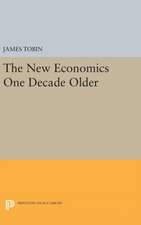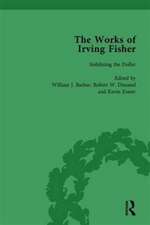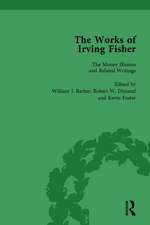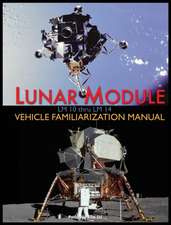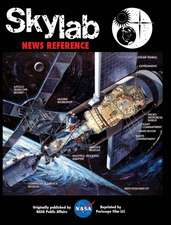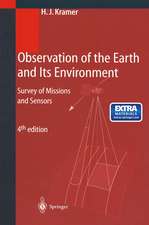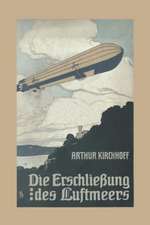To Conquer the Air: The Wright Brothers and the Great Race for Flight
Autor James Tobinen Limba Engleză Paperback – 30 apr 2004
Vezi toate premiile Carte premiată
Great Lakes Book Awards (2003)
Preț: 173.07 lei
Nou
Puncte Express: 260
Preț estimativ în valută:
33.12€ • 34.58$ • 27.41£
33.12€ • 34.58$ • 27.41£
Carte disponibilă
Livrare economică 14-28 martie
Preluare comenzi: 021 569.72.76
Specificații
ISBN-13: 9780743255363
ISBN-10: 0743255364
Pagini: 448
Dimensiuni: 133 x 224 x 29 mm
Greutate: 0.59 kg
Ediția:Reprint
Editura: Free Press
ISBN-10: 0743255364
Pagini: 448
Dimensiuni: 133 x 224 x 29 mm
Greutate: 0.59 kg
Ediția:Reprint
Editura: Free Press
Recenzii
Chicago Sun-TimesTobin is interested as much in the personalities of Orville and Wilbur Wright as he is in the technical aspects of their feat. And he outlines their lives with style and brio.
BookpageA magnificent book about magnificent men.
The Seattle TimesFabulous...fascinating...A tale about the triumph of sweat and labor over might and money. It's hard to think of a better book to bring next time one climbs aboard an airplane.
BookpageA magnificent book about magnificent men.
The Seattle TimesFabulous...fascinating...A tale about the triumph of sweat and labor over might and money. It's hard to think of a better book to bring next time one climbs aboard an airplane.
Extras
Prologue: Decoration Day, 1899 His father and sister had gone to Woodland Cemetery to plant flowers at the grave of his mother. His younger brother was busy elsewhere. It was a holiday, and the house was quiet. He could take care of the letter he had been meaning to write.
He sat, took out paper and pen, and wrote:
The subject of his letter was not the sort of thing he would mention casually to a neighbor. On this block of Hawthorn Street, on the west side of Dayton, Ohio, the houses stood so close together you could name the song somebody was playing on the piano three doors down, and make a fair guess who was playing. Any news traveled fast, and the news that somebody hoped to fly like a bird would travel faster than usual. Aspirations here tended toward the sensible. The neighbors included four carpenters, two day laborers, a machinist, a printer, a motorman, a market vendor, an insurance salesman, three widows, and two clergymen. One of the clergymen was the young man's father -- quite a prominent man, a bishop of the Church of the United Brethren in Christ, a stout widower who kept house with his schoolteacher daughter and two of his four grown sons. Their home was number 7, second from the corner of Hawthorn and West Fourth.
"When I saw this house," a visitor said later, "I felt its pathetic preeminence in a street of meager homes." It was narrow but it extended way back on the lot, with white clapboards and green shutters. At the front was the parlor, with a slant-top writing desk; a cherrywood rocking chair with horsehair upholstery; a chaise longue and a settee. In back of the parlor was the sitting room, dominated by a tall cherry bookcase, its contents suggesting a family of enthusiastic readers with broad interests, from Charles Dickens and James Fenimore Cooper to a six-volume History of France and Charles Darwin's Origin of Species. Next came a spacious dining room, with a long sideboard, a drop-leaf table, and six walnut chairs. At the rear of the house was the kitchen. Upstairs there were four small bedrooms. Out in back was a "summer kitchen" -- a detached shed -- and an outhouse. Along the front and left side of the house there was a long porch. The young man and his brother had built it in 1892. They kept it simple, leaving off the usual gingerbread trim.
The young man continued his letter:
This is what had happened to him, and the letter was part of his effort to get out of his corner. He possessed extraordinary gifts. Yet he had lived more than half the average span of an American man of his time without doing or making anything he could call his own. He lived in his father's house. The woman in his life was his sister. The children he loved belonged to his older brothers. He gave most of his time to a storefront business without caring for business or money. His only advanced education had come from his father's books. He had put his powerful mind to work in only one cause -- an obscure church controversy, also his father's. But he did not even have his father's faith.
He was "an enthusiast," he wrote:
Rathbun, an expert on marine invertebrates, handled many such inquiries each week. Like Wilbur Wright, people everywhere regarded the Smithsonian as a fountainhead of scientific and cultural information, much of it published in the Institution's own periodicals. A man once wrote to ask for all Smithsonian publications on geology, biology, botany, the National Museum, the Bureau of American Ethnology, Indians, International Exchanges, the National Zoological Park, the Astrophysical Observatory, "and any other interesting subjects." He was told that compliance with his request would require the shipment of several thousand volumes. With the financial support of the U.S. Congress and a host of private benefactors, the Smithsonian was the best-endowed, most prestigious institution of science, culture, and learning in the entire nation. Its exhibits, repositories, storehouses, laboratories, and libraries were known throughout the world, and all of these existed to fulfill the terms of the 1846 will of the Institution's founding benefactor, the Englishman James Smithson, who had called for an American institution to foster "the increase ℜdiffusion of knowledge." Every legitimate question was to receive a careful answer. So people wrote by the hundreds every year.
The letter from Dayton would have occasioned no special notice in Rathbun's office but for one salient characteristic. It raised the question of mechanical flight. This was a topic of consuming interest to the fourth secretary of the Smithsonian himself, Samuel Pierpont Langley.
In public stature and prestige, Langley was the most prominent scientist in the United States. His best friend was Alexander Graham Bell, the inventor of the telephone. Langley was a frequent guest at the White House. He dined regularly with the historian Henry Adams, grandson and great-grandson of presidents; and John Hay, who had been personal secretary to Abraham Lincoln and was now secretary of state. Langley corresponded with the likes of Rudyard Kipling and the philosopher Charles Sanders Peirce; as a young man he had listened for hours to the philosophical discourses of the great British historian Thomas Carlyle.
In the entire world only a handful of men with any standing in science had suggested that human flight was possible. Langley not only had said so, but had done more than anyone else to bring the possibility within reach. He was now the leading flight experimenter in the world, and the pursuit of human flight had become the passion of his life.
Wilbur Wright would have to contend with the doubts of his neighbors in Dayton. Secretary Langley, far more grandly and self-consciously, was assailing the arguments of Sir Isaac Newton and several of the leading mathematicians and physicists of the day, who said basic laws of logic and physics rendered human flight highly unlikely if not utterly impossible. Wright hoped to "add my mite" in the search for a solution. Langley aspired to join the pantheon of history's greatest scientists.
To build his case, Langley had undertaken a long series of experiments in aerodynamics that culminated in 1896 with the flights of two substantial flying machines -- unmanned -- over the Potomac River. He called them "aerodromes," his own coinage from the Greek, meaning "air runner."
Among the handful who saw the first unmanned flight of a Langley aerodrome was Alexander Graham Bell, who captured the only photographs of the event. That evening he jotted a note to Langley -- "I shall count this day as one of the most memorable of my life" -- and to the editor of Science he sent a resounding endorsement of the secretary's achievement: "No one could have witnessed these experiments without being convinced that the practicability of mechanical flight had been demonstrated." Certainly Bell was convinced, and he went back to his own flight experiments with new zeal.
"A 'flying-machine,' so long a type for ridicule, has really flown," Langley declared. "It has demonstrated its practicability in the only satisfactory way -- by actually flying, and by doing this again and again, under conditions which leave no doubt." As Langley's engineer later put it, the model aerodromes known as No. 5 and No. 6 were "the only things of human construction that had ever really flown for any considerable distance."
Now, three years later, with all the resources of the Smithsonian at his command, and the largest appropriation for research ever granted by the U.S. War Department, Langley was directing an entire staff in the design and construction of a much larger machine -- a machine that would carry a man. President William McKinley had taken an interest in the project, and Theodore Roosevelt, now governor of New York, had played a key role in assuring the funding. Langley expected to conduct the first trials by the end of the year.
If the secretary had been in his office that day, Richard Rathbun might have mentioned the carefully written and well-informed request for information on mechanical flight. But Langley was in Europe. He went abroad nearly every summer, to meet with his international peers in the world of science; to raise the Smithsonian's profile as an institution of world rank; and to indulge his own love for the sites of European high culture.
So Rathbun sent back a brief reply to Dayton with "a list of works relating to aerial navigation, which will probably best meet your needs," plus several Smithsonian pamphlets.
Wilbur Wright's letter was filed and forgotten.
Copyright © 2003 by James Tobin
He sat, took out paper and pen, and wrote:
The Smithsonian InstitutionWashington. Dear Sirs:He was thirty-two years old and unmarried. He was lean and bald. His lips were thin and he usually held them tightly shut; he may have been self-conscious about his teeth, which had been smashed in a hockey game years ago. His ears flared. Only his eyes saved him from outright homeliness. Ten years later, when he was one of the most famous men in the world, reporters had trouble getting him to say much about himself. So they remarked on his eyes as indicative of the character within. "This man is strange and cold," one said, "but of a coldness that is smiling and sympathetic....The countenance is remarkable, curious -- the head that of a bird, long and bony, and with a long nose...the eye is a superb blue-gray, with tints of gold that bespeak an ardent flame." He was a shrewd observer of people and of nature. Yet he once told his sister that "my imagination pictures things more vividly than my eyes."
I have been interested in the problem of mechanical and human flight ever since as a boy I constructed a number of bats of various sizes....My observations since have only convinced me more firmly that human flight is possible and practicable. It is only a question of knowledge and skill as in all acrobatic feats.
The subject of his letter was not the sort of thing he would mention casually to a neighbor. On this block of Hawthorn Street, on the west side of Dayton, Ohio, the houses stood so close together you could name the song somebody was playing on the piano three doors down, and make a fair guess who was playing. Any news traveled fast, and the news that somebody hoped to fly like a bird would travel faster than usual. Aspirations here tended toward the sensible. The neighbors included four carpenters, two day laborers, a machinist, a printer, a motorman, a market vendor, an insurance salesman, three widows, and two clergymen. One of the clergymen was the young man's father -- quite a prominent man, a bishop of the Church of the United Brethren in Christ, a stout widower who kept house with his schoolteacher daughter and two of his four grown sons. Their home was number 7, second from the corner of Hawthorn and West Fourth.
"When I saw this house," a visitor said later, "I felt its pathetic preeminence in a street of meager homes." It was narrow but it extended way back on the lot, with white clapboards and green shutters. At the front was the parlor, with a slant-top writing desk; a cherrywood rocking chair with horsehair upholstery; a chaise longue and a settee. In back of the parlor was the sitting room, dominated by a tall cherry bookcase, its contents suggesting a family of enthusiastic readers with broad interests, from Charles Dickens and James Fenimore Cooper to a six-volume History of France and Charles Darwin's Origin of Species. Next came a spacious dining room, with a long sideboard, a drop-leaf table, and six walnut chairs. At the rear of the house was the kitchen. Upstairs there were four small bedrooms. Out in back was a "summer kitchen" -- a detached shed -- and an outhouse. Along the front and left side of the house there was a long porch. The young man and his brother had built it in 1892. They kept it simple, leaving off the usual gingerbread trim.
The young man continued his letter:
Birds are the most perfectly trained gymnasts in the world and are specially well fitted for their work, and it may be that man will never equal them, but no one who has watched a bird chasing an insect or another bird can doubt that feats are performed which require three or four times the effort required in ordinary flight. I believe that simple flight at least is possible to man and that the experiments and investigations of a large number of independent workers will result in the accumulation of information and knowledge and skill which will finally lead to accomplished flight.He once remarked that for a person endowed with greater gifts than others, but lacking in the push needed for conventional success, there was "always the danger" that he would "retire into the first corner he falls into and remain there all his life."
This is what had happened to him, and the letter was part of his effort to get out of his corner. He possessed extraordinary gifts. Yet he had lived more than half the average span of an American man of his time without doing or making anything he could call his own. He lived in his father's house. The woman in his life was his sister. The children he loved belonged to his older brothers. He gave most of his time to a storefront business without caring for business or money. His only advanced education had come from his father's books. He had put his powerful mind to work in only one cause -- an obscure church controversy, also his father's. But he did not even have his father's faith.
He was "an enthusiast," he wrote:
...but not a crank in the sense that I have some pet theories as to the proper construction of a flying machine...I am about to begin a systematic study of the subject in preparation for practical work to which I expect to devote what time I can spare from my regular business. I wish to obtain such papers as the Smithsonian Institution has published on this subject, and if possible a list of other works in print in the English language...I wish to avail myself of all that is already known and then if possible add my mite to help on the future worker who will attain final success. I do not know the terms on which you send out your publications but if you will inform me of the cost I will remit the price. Yours truly,By June 1, traveling by rail, the letter arrived in Washington, where it was carried to the turreted, red-sandstone headquarters of the Smithsonian Institution, on the southern edge of the long green known then as Smithsonian Park. There the letter was opened, sorted with others of its type, and taken through echoing halls to the office of Richard Rathbun, second in command at the Smithsonian, whose duties included the oversight of the Institution's correspondence with scholars, scientists, and the merely curious in every part of the world.
Wilbur Wright
Rathbun, an expert on marine invertebrates, handled many such inquiries each week. Like Wilbur Wright, people everywhere regarded the Smithsonian as a fountainhead of scientific and cultural information, much of it published in the Institution's own periodicals. A man once wrote to ask for all Smithsonian publications on geology, biology, botany, the National Museum, the Bureau of American Ethnology, Indians, International Exchanges, the National Zoological Park, the Astrophysical Observatory, "and any other interesting subjects." He was told that compliance with his request would require the shipment of several thousand volumes. With the financial support of the U.S. Congress and a host of private benefactors, the Smithsonian was the best-endowed, most prestigious institution of science, culture, and learning in the entire nation. Its exhibits, repositories, storehouses, laboratories, and libraries were known throughout the world, and all of these existed to fulfill the terms of the 1846 will of the Institution's founding benefactor, the Englishman James Smithson, who had called for an American institution to foster "the increase ℜdiffusion of knowledge." Every legitimate question was to receive a careful answer. So people wrote by the hundreds every year.
The letter from Dayton would have occasioned no special notice in Rathbun's office but for one salient characteristic. It raised the question of mechanical flight. This was a topic of consuming interest to the fourth secretary of the Smithsonian himself, Samuel Pierpont Langley.
In public stature and prestige, Langley was the most prominent scientist in the United States. His best friend was Alexander Graham Bell, the inventor of the telephone. Langley was a frequent guest at the White House. He dined regularly with the historian Henry Adams, grandson and great-grandson of presidents; and John Hay, who had been personal secretary to Abraham Lincoln and was now secretary of state. Langley corresponded with the likes of Rudyard Kipling and the philosopher Charles Sanders Peirce; as a young man he had listened for hours to the philosophical discourses of the great British historian Thomas Carlyle.
In the entire world only a handful of men with any standing in science had suggested that human flight was possible. Langley not only had said so, but had done more than anyone else to bring the possibility within reach. He was now the leading flight experimenter in the world, and the pursuit of human flight had become the passion of his life.
Wilbur Wright would have to contend with the doubts of his neighbors in Dayton. Secretary Langley, far more grandly and self-consciously, was assailing the arguments of Sir Isaac Newton and several of the leading mathematicians and physicists of the day, who said basic laws of logic and physics rendered human flight highly unlikely if not utterly impossible. Wright hoped to "add my mite" in the search for a solution. Langley aspired to join the pantheon of history's greatest scientists.
To build his case, Langley had undertaken a long series of experiments in aerodynamics that culminated in 1896 with the flights of two substantial flying machines -- unmanned -- over the Potomac River. He called them "aerodromes," his own coinage from the Greek, meaning "air runner."
Among the handful who saw the first unmanned flight of a Langley aerodrome was Alexander Graham Bell, who captured the only photographs of the event. That evening he jotted a note to Langley -- "I shall count this day as one of the most memorable of my life" -- and to the editor of Science he sent a resounding endorsement of the secretary's achievement: "No one could have witnessed these experiments without being convinced that the practicability of mechanical flight had been demonstrated." Certainly Bell was convinced, and he went back to his own flight experiments with new zeal.
"A 'flying-machine,' so long a type for ridicule, has really flown," Langley declared. "It has demonstrated its practicability in the only satisfactory way -- by actually flying, and by doing this again and again, under conditions which leave no doubt." As Langley's engineer later put it, the model aerodromes known as No. 5 and No. 6 were "the only things of human construction that had ever really flown for any considerable distance."
Now, three years later, with all the resources of the Smithsonian at his command, and the largest appropriation for research ever granted by the U.S. War Department, Langley was directing an entire staff in the design and construction of a much larger machine -- a machine that would carry a man. President William McKinley had taken an interest in the project, and Theodore Roosevelt, now governor of New York, had played a key role in assuring the funding. Langley expected to conduct the first trials by the end of the year.
If the secretary had been in his office that day, Richard Rathbun might have mentioned the carefully written and well-informed request for information on mechanical flight. But Langley was in Europe. He went abroad nearly every summer, to meet with his international peers in the world of science; to raise the Smithsonian's profile as an institution of world rank; and to indulge his own love for the sites of European high culture.
So Rathbun sent back a brief reply to Dayton with "a list of works relating to aerial navigation, which will probably best meet your needs," plus several Smithsonian pamphlets.
Wilbur Wright's letter was filed and forgotten.
Copyright © 2003 by James Tobin
Descriere
Lauded as "a magnificent book about magnificent men" by "BookPage," this definitive work on the Wright brothers and their quest for flight also delves into their competitors, technological obstacles and personal challenges.
Notă biografică
Premii
- Great Lakes Book Awards Winner, 2003



